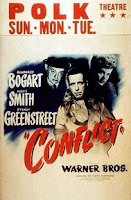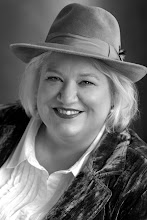
Bogie was a great actor. Sure, he had a distinct presence, a remarkable voice, and nobody could mistake him for Ronald Colman. But given those idiosyncratic and unique characteristics, he could go from Rick Blaine to an egotistical wife-killer with one twitch of the eye.
Noir City on Friday, February 1st, showcased Bogie in one of his rarest films ... Conflict. Paired with a young Alexis Smith and squared against a psychiatrist in the rotund and lovable form of Sidney Greenstreet, Humphrey plots and plans to dispose of shrewish wife (and why, I ask, don't these women ever agree to a divorce?) Rose Hobart, and succeeds ... or does he?
The story was based on a story by Robert Siodmak (the personal favorite of Eddie Muller, the Czar of Noir -- gentleman and noirmaster extraordinare), though Siodmak never got to direct it himself. Instead, the under-appreciated Curtis Bernhardt, Siodmak's mentor, creates a suspenseful noir of psychology and murder, obsession and desperation ... all the stuff we crave. ;) This baby's not on DVD, but if you can catch it on TCM, don't miss it.
Czar of Noir -- gentleman and noirmaster extraordinare), though Siodmak never got to direct it himself. Instead, the under-appreciated Curtis Bernhardt, Siodmak's mentor, creates a suspenseful noir of psychology and murder, obsession and desperation ... all the stuff we crave. ;) This baby's not on DVD, but if you can catch it on TCM, don't miss it.
The second "wife-killing" feature was actually one of my favorites of the festival ... and not just because Noir City 6 is about stretching the boundaries of noir past the middle of the twentieth century. Obviously, that's a cause I'm proud to call my own, since I'm pushing it back to the first century A.D. The Suspect is one of a few "period" films screened at the Castro this year, and it is one of the best.
Though the source material -- the novel This Way Out by James Ronald -- was not set in Edwardian England, the film is. Eddie revealed in his pre-show talk that it was really a film about Dr. Crippen -- the story that Hitchcock always wanted to film. The movie was directed by Siodmak, and is a knuckle-biter, proving once again what an incomparable actor Laughton was. His wife is an absolute harpy, a truly evil bitch of a woman, pure malice. The audience clapped when he finally got her.
The movie was directed by Siodmak, and is a knuckle-biter, proving once again what an incomparable actor Laughton was. His wife is an absolute harpy, a truly evil bitch of a woman, pure malice. The audience clapped when he finally got her.
The innocent girl he falls in love with is Ella Raines -- she of the startlingly blue eyes, even in luscious black and white. Ella projected more vulnerability than Bacall, that other famous Howard Hawks discovery, and it's in full force here.
startlingly blue eyes, even in luscious black and white. Ella projected more vulnerability than Bacall, that other famous Howard Hawks discovery, and it's in full force here.
I found that changing the film's setting enhanced the plotline and made it much more believable. Young women had fewer options in 1902, and divorce was scandalous, a sin, especially for a petit bourgeois business man like Laughton's character. And the time and place made it much more plausible that Ella might hook up with Laughton ... it also added to the sense of suffocation that hangs over the movie like Burt Lancaster with a pillow (OK, if you don't get that reference, email me). Henry Daniell (the star of many a horror film) plays a satisfyingly despicable fellow, and Rosalind Ivan channels one nasty harpy (look for her in Scarlet Street). Make no mistake -- The Suspect was as black as all night diner coffee.
So it's historical. And it's noir. It's also not on DVD, but hey--search for it. One terrific film, by Eddie's favorite director.
Later: Saturday at Noir City 6, and a Peter Lorre/Edmond O'Brien double feature of trick voices and face masks!
Saturday, February 2, 2008
Marriage-Counseling, Noir City Style
Posted by
Kelli Stanley
at
7:57 PM
![]()
![]()
Labels: Charles Laughton, Conflict, Curtis Bernhardt, Eddie Muller, Ella Raines, Humphrey Bogart, Noir City, Robert Siodmak, Sidney Greenstreet, The Suspect
Subscribe to:
Post Comments (Atom)
















No comments:
Post a Comment